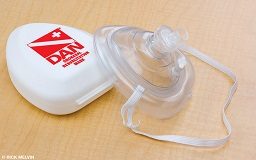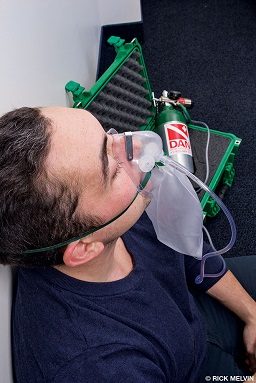When a dive accident occurs, prompt action can greatly improve the outcome — if the rescuers respond appropriately. Oxygen administration is a critical element of first aid for dive accidents, but there are several ways to do it. Oxygen units include various delivery systems, including oronasal masks, nonrebreather masks and bag valve masks, so divers should know the appropriate mask to use in each situation.
Oronasal Masks

The oronasal mask is the most versatile and effective delivery device in most circumstances. When used properly, it can deliver a high fraction of oxygen to breathing, responsive injured divers as well as unresponsive injured divers who are not breathing on their own. Rescuers can use these masks in conjunction with demand valves — the default oxygen regulator, which administers oxygen as the injured diver inhales — as well as with manually triggered ventilators, which are used to deliver breaths of oxygen to divers who are not breathing on their own.

Oronasal masks have air-cushioned edges that adapt to a variety of face shapes and elastic straps to facilitate a good seal. They also feature oxygen inlets for administering supplemental oxygen when using the mask to provide ventilations to a nonbreathing diver. Oronasal masks are reusable, provided they are cleaned and their one-way valves are replaced.
When using an oronasal mask, rescuers should ensure a good seal by using the elastic strap and proper hand positioning. When the injured diver is breathing and responsive, the diver can help with maintaining the mask seal. Rescuers using the mask for CPR or to support inadequate breathing should use two hands to create an effective seal around the entire perimeter of the mask.

Nonrebreather Masks

Nonrebreather masks are a first-aid option for distressed injured divers who are unable to activate demand valves. These single-use, disposable masks feature an attached reservoir bag that captures the flow of oxygen to the mask to ensure a ready supply. These masks do not conform to faces as effectively as oronasal masks, however, so some oxygen escapes, and some ambient air enters the mask via perimeter gaps. As a result, injured divers using nonrebreather masks receive a lower fraction of oxygen compared with oronasal masks.
When using a nonrebreather mask, it is important to tighten the mask’s elastic strap and adjust the nosepiece, but there is not much more rescuers can do to improve the mask’s efficiency. Nonrebreather masks use a continuous flow of oxygen, which exhausts the oxygen supply more quickly than with other means of oxygen delivery.
Bag Valve Masks

Bag valve masks (BVMs), which are used only on divers who are unable to breathe adequately on their own, are single-use, disposable devices that enable rescuers to provide ventilations — with or without supplemental oxygen. Using a BVM is less fatiguing for rescuers than delivering rescue breaths through oronasal masks. These masks come with flexible tubing that connects to continuous-flow outlets of oxygen units. They also have reservoir bags that collect oxygen and are capable of providing high concentrations to injured divers.

Oxygen delivery using a BVM requires two rescuers: One rescuer maintains the mask seal and the injured diver’s open airway, while the other squeezes the bulb to deliver ventilations. The other primary disadvantage of BVMs is that, like nonrebreather masks, they deplete oxygen supplies relatively quickly.
Regardless of the mask used, a rescuer’s technique affects the concentration of oxygen delivered to the injured diver. To optimize oxygen delivery, be sure to seal the mask to avoid leaks, and continually monitor both the seal and the injured diver. Do not depend on the injured diver to keep the mask secure; their comfort, changes in their level of consciousness and fatigue can compromise mask seal.
Part of being a responsible diver is familiarizing yourself with the options available in your emergency oxygen unit and inspecting it before every outing to ensure all equipment and supplies are there and in good condition. To enhance your understanding of this critical element of dive accident management, participate in a DAN® Emergency Oxygen for Scuba Diving Injuries course.

| © Alert Diver — Q1 2018 |